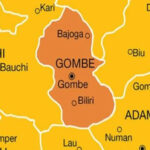Halima Abubakar is a self-taught artist specialising in Mandala, Dotilism, Tezhip and muralism. In this interview with Daily Trust on Sunday, she narrates the creative process behind her craft and her passion as an artist.
What drew you to specialise in murals, mandala art and dotilism? Were they particular experiences or influences that shaped your artistic journey?
I have always loved uniformity and attention to details. I would say what really drew me to do what I am doing now is how intricate the patterns of tezhip and geometry are. Additionally, I’m influenced by the precision and beauty of dotilism and I find joy in the process of creating intricate designs with dots by hand resulting to masterpieces.
Mandala art is often associated with spirituality and meditation. How do you infuse these elements into your mandala designs, and what significance do they hold for you personally?
For me, mandala art are decorative pieces that serve as a gateway to inner peace and self-reflection. Each stroke and pattern become a meditation in itself, helping me to centre my thoughts and find a sense of harmony. They bring some sort of calmness when looked at. I find that sitting and tracing the shapes and patterns with the eyes is so soothing and most times one gets lost deep in thought and appears to be lost in space for a moment, and I think in some ways that’s a form of meditation.
Can you share a memorable experience you’ve had while creating a mural in a public space? How did the interaction with the community impact your artistic process?
I have had quite a fair share of memorable experiences while painting walls in different communities. However, the one that stood out for me was back in 2021 when I first painted my first mosque in Ilorin. A man walked up to me and said “I struggle with my faith a lot, but ever since I have been walking into this mosque you are designing, all I just want to do is sit down longer in front of it and pray and make lots of duas”. The way each community welcomes and appreciates my works makes me believe in my purpose stronger.
- Aisha Augie assumes Centre for Black and African Arts
- Lagos Biennial Arts show to scratch Nigeria’s layers of history’
Dotilism requires meticulous attention to details. What techniques or tools do you use to maintain precision and consistency in your dot art pieces?
I started out using things I could find around the home like bottoms of pencil, dropper, cotton bud and broomsticks back in 2020 during the lockdown. I got the tools (Dotilism toolkit) at my earliest convenience. Additionally, techniques like controlling pressure and spacing between dots can contribute to achieving detailed and precise results. Practice and patience are also key elements in mastering the technique of dotilism, allowing you to refine your skills over time and produce intricate artwork with precision.
Murals have the power to transform a space and evoke emotional responses from viewers. Is there a particular message or feeling you aim to convey through your mural work?
Through my mural work, I aim to evoke a sense of unity and connection with the surrounding environment. Each mural is an opportunity to tell a story, promoting environmental awareness, and simply bringing joy and inspiration to those who encounter it. Ultimately, I strive to create immersive experiences that spark curiosity, ignite imaginations, and foster a deeper appreciation for the world around us.
Mandala art often incorporates intricate patterns and symmetry. How do you strike a balance between precision and creativity when designing mandalas?
I start by sketching a rough outline, establishing the basic symmetry and structure of the mandala. Then, as I progress, I allow myself to explore and improvise within that framework, embracing imperfections as part of the creative process. By alternating between careful attention to detail and spontaneous expression, I achieve a balance.
Can you walk us through your creative process when starting a new mural project? How do you translate your initial concept into a tangible work of art?
I begin by brainstorming ideas and concepts based on the theme or message I want. Once I have a clear concept in mind, I create preliminary sketches and design drafts to map out the composition, scale, and colour palette of the mural. Before starting the actual painting process, I prepare the surface of the wall by cleaning, priming, and sometimes applying a base coat. I usually start with outlining the main elements and gradually fill in details, layering colours and textures to bring the mural to life. By following these steps, I translate my initial concept into a tangible work of art that not only enhances the physical space but also resonates with and inspires those who encounter it.
Dotilism involves layering countless dots to create texture and depth. How do you decide on the colour palette for your dot art pieces, and how does it contribute to the overall impact of the artwork?
The layering of dots allows for the blending of colours and the creation of subtle gradients, adding texture and depth to the artwork. I consider how different colours will blend and interact when layered on top of each other, before adjusting the placement of dots accordingly.
Murals can serve as a form of public art activism, addressing social or political issues. Have you ever used your murals as a platform to advocate for a cause or convey a message?
Yes, I’ve used my murals as a platform to advocate for various causes and convey meaningful messages. For example, I’ve created murals that promote inclusivity, murals that highlight social justice issues such as gender empowerment. Through the powerful visual medium of murals, I strive to spark conversations and inspire positive change in the community.
Mandalas are often associated with different cultures and traditions. How do you incorporate cultural influences into your mandala designs while maintaining authenticity and respect?
Whenever possible, I collaborate with artists or community members who have direct knowledge and expertise in the cultural traditions I’m drawing inspirations from.
Dotilism requires a great deal of patience and precision. How do you stay motivated during the time-consuming process of creating dot art?
Staying motivated during the time-consuming process of creating dot art requires a combination of passion, discipline and mindfulness. I remind myself of my love for dot art and the satisfaction I feel when seeing a piece come together. Cultivating a deep passion for the art form fuels my motivation and drives me to persevere through the process.
Murals have the potential to transform not only physical spaces but also the perception of those spaces. How do you believe your murals contribute to the cultural identity of the communities where they’re located?
Beyond conveying specific messages or themes, my murals also contribute to the aesthetic enhancement of public spaces, transforming drab walls into vibrant, visually engaging works of art. This beautification and design not only improve the physical environment but also enhances the overall quality of life for residents as art serves as therapy.
Mandala art is often used as a form of therapy and self-expression. Have you found creating mandalas to be personally transformative, and if so, in what ways?
The process of creating mandalas requires focused attention and a meditative mind-set, which helps me quiet my thoughts and cultivate a sense of calm and inner peace. Mandala art also provides a creative outlet for self-expression and exploration, allowing me to express my thoughts, emotions, and experiences in a visual and symbolic form. Through the act of creating mandalas, I’ve gained deeper insights into myself and discovered new level of my creativity.




